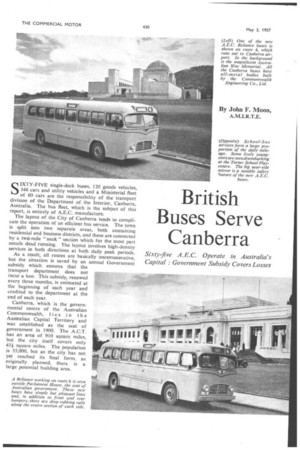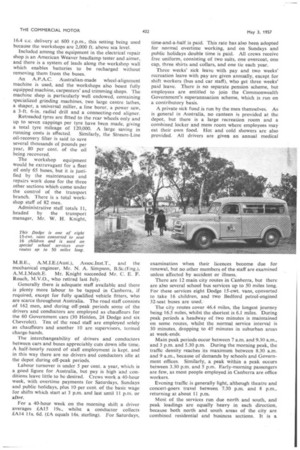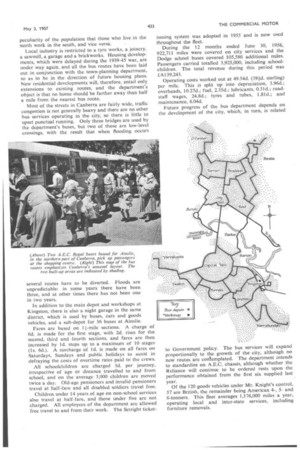British Buses Serve Canberra
Page 114

Page 115

Page 116

Page 117

If you've noticed an error in this article please click here to report it so we can fix it.
Sixty-five A.E.C. Operate in Australia's Capital. Government Subsidy Covers Losses By John F. Moon,
A.M.I.R.T.E.
SLXTY-FIVE single-deck buses, 120 goods vehicles, 346 cars and utility vehicles and a Ministerial fleet of 60 cars are the responsibility of the transport division of the Department of the Interior, Canberra, Australia. The bus fleet, which is the subject of this report, is entirely of A.E.C. manufacture.
The layout of the City of Canberra tends to complicate the operation of an efficient bus service. The town is split into two separate areas, both containing residential and business districts, and these are connected by a twq-rnife " neck " section which for the most part entails dead running. The layout involves high-density services in both directions at both daily peak periods. As a result, all routes are basically unremunerative, but the situation is saved by an annual Government subsidy which ensures that the transport department does not incur a loss. This subsidy, renewed every three months, is estimated at the beginning of each year and credited to the department at the end of each year.
Canberra, which is the govern mental centre of the Australian Commonwealth, lies i n the Australian Capital Territory and was established as the seat of government in 1900. The A.C.T. has an area of 910 square miles, but the city itself covers only 43+ square miles. The population is 35,000, but as the city has not yet reached its final form, as originally planned, there is a large potential building area. The city is unique in having been built from the start to a planned layout, the designer being Mr. Walter B. Griffin, an American. Mr. Griffin termed himself a landscape architect and so tended to emphasize the ornamental rather than the functional aspects of planning a new city. Thus the original complexity of the street layout now has to deal with an amount of road transport unvisualized in 1911, when the design was first inaugurated, and present-day planners are having to make extensive alterations to Mr. Griffin's scheme in certain areas.
As might be expected, there are no large factories in Canberra, the complete area being devoted to residential, shopping, business and administrative buildings, all attractively separated by ornamental parks and gardens. with the MoIonglo river dividing the two sections of the city. The area is undulating, heights above sea level within the area ranging between 1,800 ft. and 2,600 ft.
Canberra City Omnibus Services were started in 1926. By 1932, the fleet consisted of six A.E.C., four Bean and three Associated-Daimler buses. Originally, the department came under the control of the Federal Capital Commission, but is now a section of the Department of the Interior, which is generally responsible for all transport in the whole of the Commonwealth.
79-Passenger Regals Of the 65 -A.E.C. in the fleet, 59 have Regal chassis, powered by 7.7-litre oil engines, and 39-seat bodies with space for 40 standing passengers. Six of the Regals were replaced early in 1956 by Reliance underfloorengined models, and these have 42-seat bodies with standing room for 21 passengers. Of the Regal chassis, 41 were purchased in 1939, 12 in 1948 and the remainder in 1950. It is intended to replace older Regals with Reliance buses.
All bodies have been designed to meet the requirements of the Australian Vehicle Standards Committee, these standards affecting overall dimensions, axle loadings, seating layouts and even the electrical equipment. All the buses have all-steel bodies, most of which have been built by the Commonwealth Engineering Co., Ltd., of Granville, New South Wales. Forward entrances and rear exits are used, and other details include the provision of front and rear bumpers, four destination indicators (one front, one rear and one
on each side) and horizontally sliding windows on each side.
Maintenance is carried out along fixed lines, but drivers daily inspect such items as the steering, brakes and lubricant levels. At the end of each shift, each driver signs his vehicle as being in fit running order. Three times a week the tyre pressures are checked and the covers are inspected.
Every 500 miles each chassis is thoroughly greased and at 1,500-mile periods engine oil is changed. Old oil is reclaimed through a Stream-Line filter and re-issued to the maintenance bays.
Brakes Tested Regularly
Tune and filter" checks are given every 3,000 miles. These consist of checking the engine timing, changing the fuel and lubricant filter elements, and testing the wheel brakes. The brakes are tested by Tapley meter, and an efficiency of at least 50 per cent. when braking from 20 m.p.h. is demanded.
Every 25,000 miles (or approximately every 15 months) a " desludge " overhaul is given. This is a particularly thorough maintenance period, and if an engine is found to need a major overhaul a spare unit is fitted. Two spare engines are held in stock, these being reconditioned at the A.E.C. headquarters in Sydney. No gearbox or rear-axle assemblies are kept in store, because so far no trouble has been experienced with any of these units. All the Regal buses have constant-mesh gearboxes.
Engines which do not demand replacement have their heads and sumps removed, and the pistons are drawn. The crankcases are then flushed with paraffin; pistons, piston rings, cylinder liners and bearings are checked; fuel pumps are inspected and recalibrated in the pump room; injectors are exchanged f o r reconditioned units; reconditioned cylinder heads are fitted, and dynamos and starters removed, dismantled and checked.
At the same time, bodies undergo a thorough inspection, with particular emphasis on the trim, seats and floor coverings. All accessories are also carefully examined. The " desludge " overhauls last a week, and one vehicle per week is put through this process.
Body repainting is done when necessary. At present, each body is repainted, on the average, every six years, although the aim is to cut this time down to three to four years.
The 25,000-mile overhauls, together with the more frequent routine attentions, ensure a general availability figure of 93 per cent., which is particularly good considering that only five fitters are employed in the workshops on buses alone.
The workshops are combined with the main depot at Kingston and, although the fleet is relatively small, they are comprehensive. They include such specialized departments as a properly dust-proofed shop for servicing fuel-injection equipment and a fully equipped electrical repair bay. The fuel-injection room contains a Hartridge tester, Merlin grinder and 41-in. lathe, and all pumps are calibrated at 25,000-mile intervals.
All pumps are set to ensure a clean exhaust with a
16.4 c.c. delivery at 600 r.p.m., this setting being used because the workshops are 2,000 ft. above sea level. Included among the equipment in the electrical repair shop is an American Weaver headlamp tester and aimer, and there is a system of leads along the workshop wall
which enables batteries to be recharged without removing them from the buses.
An A. P.A.C. Australian-made wheel-alignment machine is used, and the workshops also boast fully equipped machine, carpenters' and trimming shops. The machine shop is particularly well endowed, containing specialized grinding machines, two large centre lathes, a shaper, a universal miller, a line borer, a power saw, a 3-ft. 6-in, radial drill and a connecting-rod aligner. Retreaded tyres are fitted to the rear wheels only and up to seven cappings per tyre have been made, giving a total tyre mileage of 120,000. A large saving in running costs is effected. Similarly, the Stream-Line oil-recovery filter is said to save several thousands of pounds per year, 80 per cent, of the oil being recovered.
The workshop equipment would be extravagant for a fleet of only 65 buses, but it is justified by the maintenance and repairs work done for the three other sections which come under the control of the transport branch. There is a total workshop staff of 82 men.
Administrative staff totals 11, headed by the transport manager, Mr. W. H. Knight, M.B.E., A.M.I.E.(Aust.), Assoe.Inst.T., and the mechanical engineer, Mr. N. A. Simpson, B.Sc.(F,ng.), A.M.1.Mech.E. Mr. Knight succeeded Mr. C. E. F. Roach, M.V.O., who retired last July.
Generally there is adequate staff available and there is plenty more labour to be tapped in Canberra, if required, except for fully qualified vehicle fitters, who are scarce throughout Australia. The road staff consists of 162 men, and during off-peak periods some of the drivers and conductors are employed as chauffeurs for the 60 Government cars (30 Holden, 24 Dodge and six Chevrolet). Ten of the road staff are employed solely as chauffeurs and another 10 are supervisors, termed charge-hands.
The interchangeability of drivers and conductors between cars and buses appreciably cuts down idle time. A half-hourly record of staff employment is kept, and in this way there are no drivers and conductors idle at the depot during off-peak periods.
Labour turnover is under 5 per cent, a year, which is a good figure for Australia, but pay is high and conditions leave little to be desired. Crews work a 40-hour week, with overtime payments for Saturdays, Sundays and public holidays, plus 10 per cent. of the basic wage for shifts which start at 3 p.m. and last until 11 p.m. or after.
For a 40-hour week on the morning shift a driver averages LA15 19s., whilst a conductor collects LA14 I Is. 6d. (LA equals 16s. sterling). For Saturdays, time-and-a-half is paid. This rate has also been adopted for normal overtime working, and on Sundays and public holidays double time is paid. All crews receive free uniform, consisting of two suits, one overcoat, one cap, three shirts and collars, and one tie each year.
Three weeks' sick leave with pay and two weeks' recreation leave with pay are given annually, except for shift workers (bus and car staff), who get three weeks' paid leave. There is no separate pension scheme, hut employees are entitled to join the Commonwealth Government's superannuation scheme, which is run on a contributory basis.
A private sick fund is run by the men themselves. As is general in Australia, no canteen is provided at the depot, but there is a large recreation room and a combined locker and mess room where employees may eat their own food. Hot and cold showers are also provided. All drivers are given an annual medical
examination when their licences become due for renewal, but no other members of the staff are examined unless affected by accident or illness..
There are 12 main city routes in Canberra, but there are also several school bus services up to 50 miles long. For these services eight Dodge 15-cwt. vans, converted to take 16 children, and two Bedford petrol-engined 32-seat buses are used.
The city routes cover 46.4 miles, the longest journey being 16.5 miles, whilst the shortest is 6.1 miles. During peak periods a headway of two minutes is maintained on some routes, whilst the normal service interval is 30 minutes, dropping to 45 minutes in suburban areas at week-ends.
Main peak periods occur between 7 a.m. and 9.30 a.m., and 3 p.m. and 5.30 p.m. During the morning peak, the traffic density reaches its maximum between 8.30 a.m. and 9 a.m., because of demands by schools and Government offices. Similarly, a peak within a peak occurs between 3.30 p.m. and 5 p.m. Early-morning passengers are few, as most people employed in Canberra are office workers.
Evening traffic is generally light, although theatre and concert-goers travel between 7.30 p.m. and 8 p.m., returning at about 11 p.m.
Most of the services run due north and south, and peak loadings are equally heavy in each direction, because both north and south areas of the city are combined residential and business sections. It is a
peculiarity of the population that those who live in the north work in the south, and vice versa.
Local industry is restricted to a tyre works, a joinery, a sawmill, a garage and a brickworks. Housing developments, which were delayed during the 1939-45 war, are under way again, and all the bus routes have been laid out in conjunction with the town-planning department, so as to be in the direction of future housing plans. New residential developments will, therefore, entail only extensions to existing routes, and the department's object is that no home should be farther away than half a mile from the nearest bus route.
Most of the streets in Canberra are fairly wide, traffic congestion is not generally heavy and there are no other bus services operating in the city, so there is little to upset punctual running. Only three bridges are used by the department's buses, but two of those are low-level crossings, with the result that when flooding occurs several routes have to be diverted. Floods are unpredictable: in some years there have been three, and at other times there has not been one in two years.
In addition to the main depot and workshops at Kingston, there is also a night garage in the same district, which is used by buses, cars and goods vehicles, and a sub-depot for 36 buses at Ainslie.
Fares are based on 11-mile sections. A charge of 6d. is made for the first stage, with 2d. rises for the second, third and fourth sections, and fares are then increased by 1d. steps up to a maximum of 10 stages (Is. 6d.). A surcharge of Id. is made on all fares on Saturdays, Sundays and public holidays to assist in defraying the costs of overtime rates paid to the crews.
All schoolchildren are charged 3d, per journey, irrespective of age or distance travelled to and from school, and on the average 3,000 children are moved twice a day. Old-age pensioners and invalid pensioners travel at half-fare and all disabled soldiers travel free.
Children under 14 years of age on non-school services also travel at half-fare, and those under five are not charged. All employees of the department are allowed free travel to and from their work. The Setright ticket
issuing system was adopted in 1955 and is now used throughout the fleet.
During the 12 months ended June 30, 1956, 922,711 miles were covered on city services and the Dodge school buses covered 105,586 additional miles. Passengers carried totalled 3,925,000, including schoolchildren. The total revenue during this period was £A139,243.
Operating costs worked out at 49.54d. (391d. sterling) per mile. This is split up into depreciation, 3.96d.; overheads, 10.27d.; fuel, 2.35d.; lubricants, 0.31d.; roadstaff wages, 24.8d.; tyres and tubes, 1.81d.; and maintenance, 6.04d.
Future progress of the bus department depends on the development of the city, which, in turn, is related to Government policy. The bus services will expand proportionally to the growth of the city, although no new routes arc conlemplated. The department intends to standardize on A.E.C. chassis, although whether the Reliance will continue to be ordered rests upon the performance obtained from the first six supplied last year.
Of the 120 goods vehicles under Mr. Knight's control, 57 are British, the remainder being American 4-, 5and 6-tonners. This fleet averages 1,176,000 miles a year, operating local and inter-state services, including furniture removals.












































































































































































































































